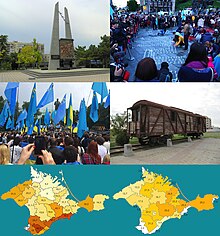| Deportation of the Crimean Tatars | |
|---|---|
| Part of forced population transfer in the Soviet Union, De-Tatarization of Crimea, and World War II | |
 Left to right, top to bottom: Memorial to the deportation in Eupatoria; candle-lighting ceremony in Kyiv; memorial rally in Taras Shevchenko Park; cattlecar similar to the type used in the deportation; maps comparing the demographics of Crimea in 1939 and 2001 | |
| Location | Crimea |
| Date | 18–20 May 1944 |
| Target | Crimean Tatars |
Attack type | Forced population transfer, ethnic cleansing, genocide[1] |
| Deaths | Several estimates a) 34,000[2] b) 40,000–44,000[3] c) 42,000[4] d) 45,000[5] e) 109,956[6] f) 195,471 [7] |
| Victims | 191,044 to 423,100 Crimean Tatars deported to forced settlements in the Soviet Union |
| Perpetrators | NKVD, the Soviet secret police |
| Motive | Tatarophobia, Islamophobia, Russification,[8] Colonialism[9] |
The deportation of the Crimean Tatars (Crimean Tatar: Qırımtatar halqınıñ sürgünligi, Cyrillic: Къырымтатар халкъынынъ сюргюнлиги) or the Sürgünlik ('exile') was the ethnic cleansing and the cultural genocide[c 1] of at least 191,044[c 2] Crimean Tatars that was carried out by Soviet Union authorities from 18 to 20 May 1944, supervised by Lavrentiy Beria, chief of Soviet state security and the secret police, and ordered by the Soviet leader Joseph Stalin. Within those three days, the NKVD used cattle trains to deport the Crimean Tatars, even Soviet Communist Party members and Red Army members, from Crimea to the Uzbek SSR, several thousand kilometres away. They were one of several ethnicities that were subjected to Stalin's policy of population transfer in the Soviet Union.
Officially, the Soviet government presented the deportation as a policy of collective punishment, based on its claim that some Crimean Tatars collaborated with Nazi Germany in World War II,[13] despite the fact that the 20,000 who collaborated with the Axis powers were half the 40,000 who served in the Soviet Red Army. Several modern scholars believe rather that the government deported them as a part of its plan to gain access to the Dardanelles and acquire territory in Turkey, where the Turkic ethnic kin of the Tatars lived, or remove minorities from the Soviet Union's border regions. By the end of the deportation, not a single Crimean Tatar lived in Crimea, and 80,000 houses and 360,000 acres of land were left abandoned. Nearly 8,000 Crimean Tatars died during the deportation, and tens of thousands subsequently perished due to the harsh living conditions in which they were forced to live during their exile.[4] After the deportation, the Soviet government launched an intense detatarization campaign in an attempt to erase the remaining traces of Crimean Tatar existence.
In 1956, the new Soviet leader Nikita Khrushchev condemned Stalin's policies, including the deportation of various ethnic groups, and he allowed most of these ethnic groups to return to their homelands, but he did not lift the directive that forbade the Crimean Tatars from returning. The Crimean Tatars remained in Central Asia for the next three decades, until the perestroika era of the late 1980s, when 260,000 of them returned to Crimea, after 45 years in exile. On 14 November 1989, the Supreme Council of the Soviet Union declared that the deportations had been a crime, and declared that the ban on their return to Crimea was officially null and void.
By 2004, the number of Crimean Tatars who had returned to Crimea had increased their share of the peninsula's population to 12 percent. The Soviet authorities had not assisted them during their return to Crimea nor had it compensated them for the land they lost in the deportation. The deportation and the subsequent assimilation efforts in Asia are crucial events in the history of the Crimean Tatars. Between 2015 and 2024, the deportation was formally recognised as a genocide by Ukraine, Lithuania, Latvia, Canada, Poland and Estonia.
- ^ Naimark 2010, pp. 2–14, 126, 135.
- ^ Cite error: The named reference
buckley207was invoked but never defined (see the help page). - ^ Williams 2015, p. 109.
- ^ a b Rywkin 1994, p. 67.
- ^ Ukrainian Congress Committee of America 2004, pp. 43–44.
- ^ Hall 2014, p. 53.
- ^ The Tatars of the Crimea : return to the homeland : studies and documents. Internet Archive. Durham : Duke University Press. 1998. ISBN 978-0-8223-1985-6.
{{cite book}}: CS1 maint: others (link) - ^ Bekus, Nelly (1 January 2010). Struggle Over Identity: The Official and the Alternative "Belarusianness". Central European University Press. p. 42. ISBN 978-963-9776-68-5.
- ^ Casey Michael (9 August 2022). "Russia's Crimes of Colonialism". Wall Street Journal.
- ^ Закон РСФСР от 26 апреля 1991 г. N 1107-I «О реабилитации репрессированных народов» (с изменениями и дополнениями) Article 2 "Репрессированными признаются народы (нации, народности или этнические группы и иные исторически сложившиеся культурно-этнические общности людей, например, казачество), в отношении которых по признакам национальной или иной принадлежности проводилась на государственном уровне политика клеветы и геноцида, сопровождавшаяся их насильственным переселением, упразднением национально-государственных образований, перекраиванием национально-территориальных границ, установлением режима террора и насилия в местах спецпоселения"
- ^ Закон «О реабилитации репрессированных народов» (1991) // РИА — 26.04.2016
- ^ Allworth 1988, p. 6.
- ^ Bezverkha 2017, p. 127.
Cite error: There are <ref group=c> tags on this page, but the references will not show without a {{reflist|group=c}} template (see the help page).